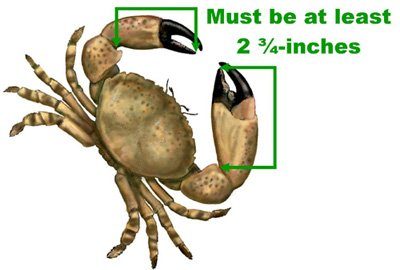Florida’s recreational and commercial stone crab claw harvest season opens Oct. 15 in state and federal waters. To ensure this valuable resource is available for generations to come, take care when removing crab claws and follow all protective management guidelines for stone crab harvest.
Stone crabs occur throughout Florida waters, but most of the harvest comes from Southeast Florida, the Florida Keys and Southwest Florida.
Gulf stone crab are found from northwest Florida around the Gulf of Mexico to the state of Tamaulipus, Mexico. Florida stone crab are found from west central Florida around the peninsula to east central Florida and North Carolina. An extensive hybrid zone occurs from the big bend area of Florida to west central Florida, and a smaller hybrid zone occurs from east central Florida through South Carolina. A hybrid zone is where the range of the two interbreeding species meet.

To be harvested, stone crab claws must be at least 2¾ inches in length when measured from the elbow to the tip of the lower immovable portion of the claw (see illustration). View a video on how to properly remove the claw ![]() and increase the likelihood of survival of the released crab.
and increase the likelihood of survival of the released crab.
Claws may not be taken from egg-bearing stone crabs. Egg-bearing females are identifiable by the orange or brown egg mass, also known as a “sponge,” which is visible on the underside of the crab when it is picked up or turned over.
Recreational harvesters can use up to five stone crab traps per person. Stone crabs may not be harvested with any device that can puncture, crush or injure a crab’s body. Examples of devices that can cause this kind of damage include spears and hooks. Recreational and commercial traps may be baited and placed in the water 10 days prior to the opening of the season, but may not be pulled from the water for harvest purposes until Oct. 15. Traps that are not being fished should be removed from the water to avoid ghost fishing, a process in which marine species get caught in the trap for extended periods of time and are not harvested.


Round entrances (also known as throats or funnels) are not allowed for stone crab traps used in state or federal waters off Collier, Monroe and Miami-Dade counties. The rectangular or rounded rectangular entrances typically used in stone crab traps in these waters must be no larger than 5½ by 3 1/8 inches at the most narrow portion of the opening. Stone crab traps being used in other areas of the state may have an entrance that is 5½ by 3½ inches.
Harvesters are encouraged to take only one claw, even if both claws are of legal size, so that the released crab will be better able to defend itself from predators. A crab that is returned to the water with one claw intact will be able to obtain more food in a shorter amount of time and therefore regrow its claw faster. There is a recreational daily bag limit of 1 gallon of claws per person or 2 gallons per vessel, whichever is less.
The season will be open through May 15, 2017, closing May 16.
Stone crab regulations are the same in state and federal waters.
For more information on harvesting stone crabs for recreation, as well as commercial stone crab regulations and licensing information, go online to MyFWC.com/Fishing (click on “Saltwater”).



